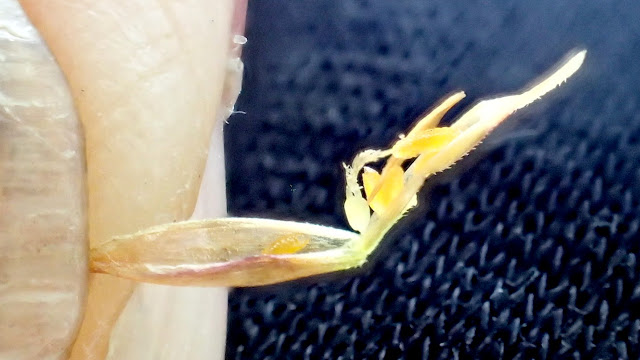 |
| Red Fescue has rhizomes - it is a spreading plant. Here it is placed on 1 cm graph paper |
Festuca rubra has needle-like leaves - as narrow as a bristle.
It grows in lawns.
 |
| Upper blades of Red Fescue can be held over the finger and opened out and flattened |
You can flatten out the upper leaves with your finger nail, and if you wrap it over your finger you can see grooves.
But the basal leaves you just cannot flatten. They are needle-like.
I've chosen Festuca rubra grass because nearly everyone in the UK
should be able to go out and find some outside their house/flat,
if not in a lawn nearby, then maybe in a city park, or a road verge.
(It grows in North America and Northern Europe too.)
January is a cold month - but I just opened the door
and crossed the road
and picked some from the verge opposite,
and some from a little further along, from a three year old pile of soil.
(It grows in North America and Northern Europe too.)
January is a cold month - but I just opened the door
and crossed the road
and picked some from the verge opposite,
and some from a little further along, from a three year old pile of soil.
There are only four relatively common grasses that have needle-like leaves. So they can be distinguished from all the other common grasses which have broader leaves.
Easy.
In the first four months of 2011 I shall show how to distinguish the four grasses with needle like leaves.
Red Fescue is the only one that grows in "ordinary" places. The other three only grow where there are very low nutirents, mostly on bogs or heaths where the soil is acid, (though Sheep's Fescue will grow on chalk and limestone as well.)
- Mat Grass- (Nardus stricta) grows on peat or acid sandy soils and moors, especially slightly damper soil.
- Wavy Hair-grass (Deschapsia flexuosa) grows on acid soils - with Mat grass - but also on drier acid soils and under trees on acid soil, and under conifer plantations - the needles make the soil acid.
- Sheep's Fescue (Festuca ovina) grows on acid soil as the above two species and also on very basic places (i.e. chalk and limestone)
- That leaves Red-Fescue (Festuca rubra)- which grows in low nutrient soil that is not acid and medium nutrient soil. (If lots of fertilizer is put on a field it will get out-competed by Rye-grass)
There are actually many varieties of Red Fescue, some having been bred for use in turf, but here we are lumping them all as "Red Fescue" .
 |
| Tubular sheath |
So what if you are on the border between two habitats? How do you to distinguish Festuca rubra from the other the three species if they are not in flower?
Answer: Look at the blade-sheath junction
This picture illustrates three useful features:-
1. The ligule is very short
2. The sheath is tubular and the top of the sheath is like a v-necked jumper (as seen more clearly below right)
3. To check that the sheath is a tube, rather than having two overlapping edges, the sheath has been bent - the sheath crinkles a little - but there is no separating of two sides of the sheath. - Next month we'll look at Festuca ovina which has open sheaths.
 |
| top of tubular sheath has the appearance of a v-necked jumper |
I found the remains of a flowering shoot
Here at the tip you can see a complete spikelet on the right, with florets with awns (bristles) and with two glumes at the base of the spikelet - then on the left is the base of a spikelet with just two glumes left. the florets have gone.
 |
| Two glumes are all that remain of the spikelet. Note that the lower glume is bigger than the upper glume |
Why not go out and look in a lawn near you, find a needle-like grass and say "Hello - I've found some Red Fescue".
In June 2024 I looked for some Festuca rubra to show my Zoom group.
I opened up a floret:-
 |
| Three and a bit spikelets. There are two green glumes at the base of each spikelet |
I suppose the lemmas that look brown are the ones infected with these orange insect larvae.
 |
| Two glumes - the rest of the spikelet has been removed. |






No comments:
Post a Comment